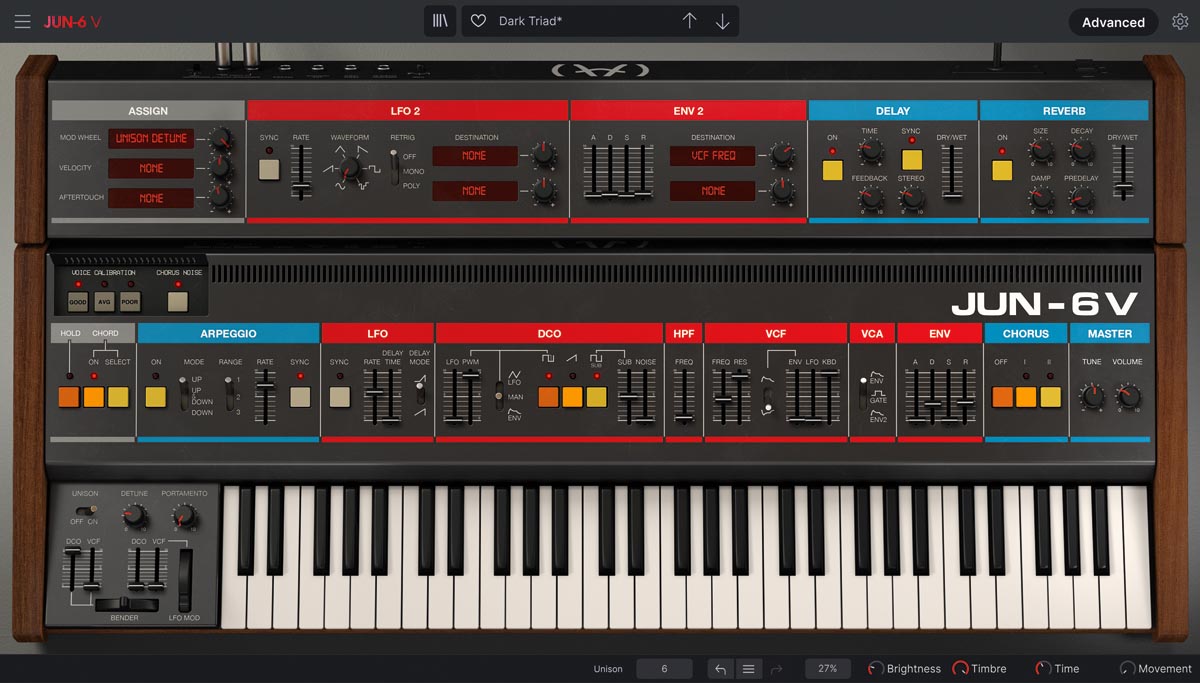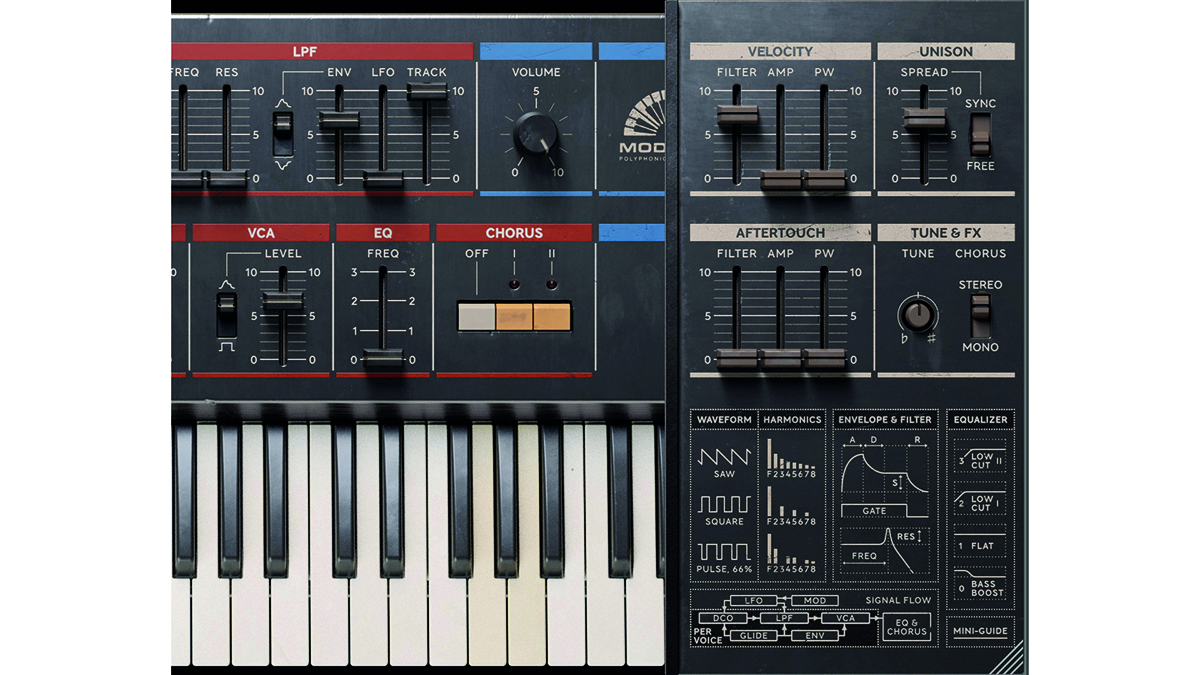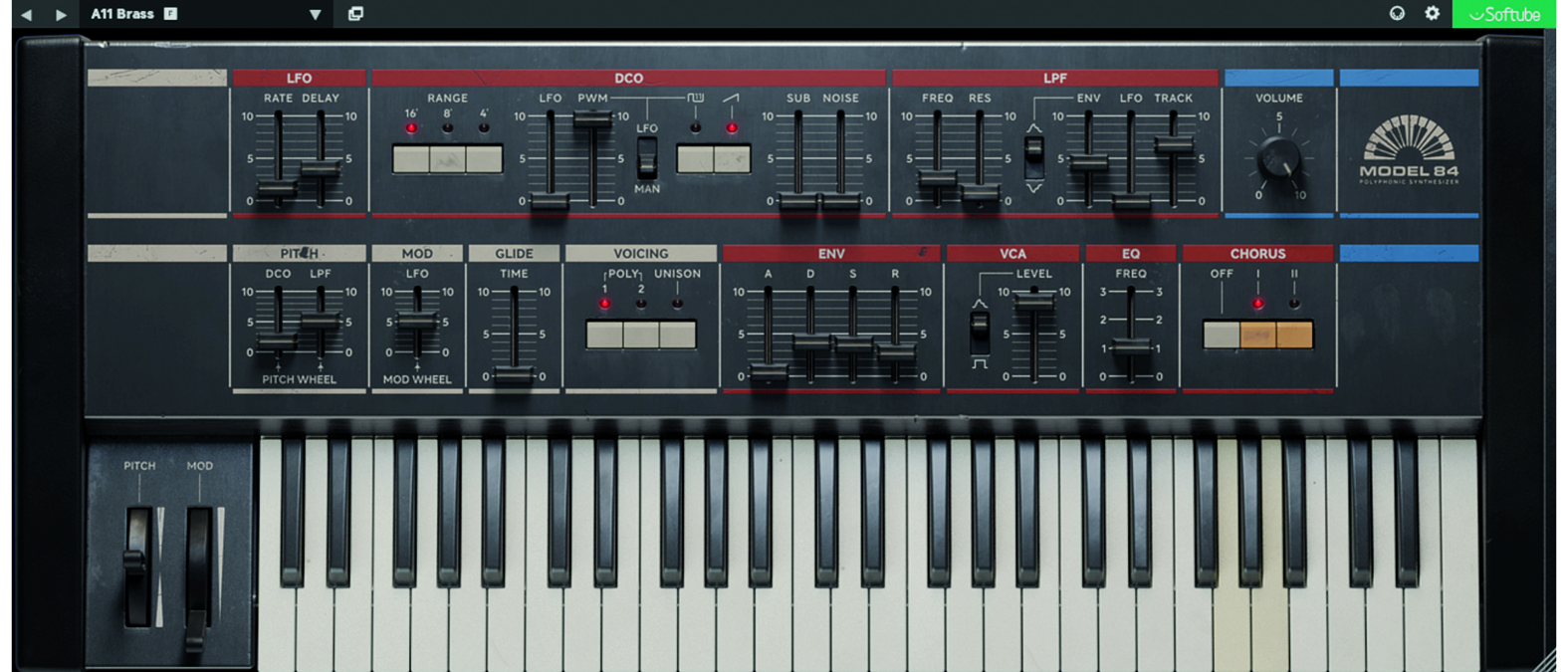MusicRadar Verdict
This is a great clone of the original Juno 106, which sounds relatively authentic, but it’s a shame that enhancements weren’t incorporated to breathe new life in.
Pros
- +
Cool-sounding facsimile.
- +
The GUI is really inviting.
- +
Great emphasis placed on accuracy.
- +
The Chorus is nice and clean.
- +
EQ Bass boost does the job brilliantly!
Cons
- -
Lacking embellishments.
- -
No standalone version.
MusicRadar's got your back
Softube Model 84: What is it?
Back in the 80s, Roland had the good sense to do a really smart thing. The late 70s poly-synth behemoths, which in many cases required hair of a similar magnitude, were big, bloated and expensive.
This provoked a reaction from Roland to produce a more affordable polysynth, in part thanks to the shrinking of electronic components, that made a sensible price point more obtainable. And so the path was laid for the future classics from the Juno Series.
With reference to Greek mythology, Juno was the wife of Jupiter, better known among mere synth-mortals as the flagship synthesizers in the Roland range. Anyway, Roland created the Juno 6; a six-note polyphonic synth, now recognised as a vintage classic.
Within a matter of months, the Juno 60 appeared. In essence, this was the same synth but with added patch memories and a connectivity format called DCB (Digital Communication Buss) which allowed easy connection to Roland sequencers et al.
Analogue issues aside
Those earlier Junos sounded rich and deep, in part thanks to the rather noisy chorus circuit, placed on the backend of the signal. The premise being that with only one oscillator per voice on board, the chorus would help thicken the sound, and so it did!
Fast-forward, then, to 1984, and the third coming of the Juno arrived in the shape of the 106. Gone were the wooden end-cheeks, arpeggiator and DCB. In came portamento (glide) and a new protocol called MIDI, in one of its first fully-fitted deployments.
Roland went to huge efforts to prove that the analogue stylings of the 106 could compete with the DX7
At the time, Roland was going to quite considerable efforts to try and prove that the analogue stylings of the 106 could compete with the new great pretender from Yamaha, called the DX7. Hence the sound of the 106 was tighter, sharper and crisper.
The argument about which Juno sounds better is one that we’ll save for another day, but it is nevertheless significant that the 106 has its notable fans, for punchy synth lines and weighty basses, within the commercial and production psyche today. This might explain why Softube has zoned its 24k magic on the 106, in much the same way that the recently applauded Model 72 provides a MiniMoog re-born.
Softube Model 84: Performance and verdict
The fashionable architecture of the Juno is carried forward to the Model 84, through a familiar fascia. With reverence to most second hand originals, the paint work appears chipped and scratched, with a couple of lumps taken out of the rear edge, presumably where it’s been slammed up against its ‘virtual’ X-frame keyboard stand.
It sounds über cool, with the DCOs presenting an almost perfect match to the original harmonic makeup
It looks really cool and engaging, but more importantly, it sounds über cool, with the DCOs presenting an almost perfect match to the original harmonic makeup. The early Juno synth range used a form of oscillator which was overtly analogue, but placed under digital control. Hence they were known as DCOs (rather than VCOs), producing more reliable tuning stability, unlike the synth cousins from some years earlier.
As this is a virtual facsimile, Softube has sought to follow through the 106 thread, with buttons allowing the activation of the fundamental saw and square waves. There is no volume control for either, but there is a fader to control the sub-oscillator volume. This is pretty essential, as the sub can quickly obscure the fundamental, while associated with more polyphonic patching.
Pulse Width Modulation (PWM) is applied to the square/pulse wave, either through manual control to LFO modulation. The earlier Junos also allowed for envelope control of PWM, and while it’s easy to get dragged along with the attention to 106 detail, that’s one addition that would’ve been a welcome reintroduction for the Model 84, although Softube has implemented an additional control panel, which springs open from the right of the window, allowing PWM control via velocity and aftertouch.

• Arturia Jun-6 v
Close to the original Juno 6, but with added patch capability and other modernising enhancements.
• Roland Juno 106
Truly authentic emulation, with some tasty enhancements.
The filter, being a 4-pole design, sounds incredibly exacting. Softube has even recreated the obvious stepping, exaggerated in self-oscillation, which was a recognisable trait for the 106. The resultant sine sounds incredibly accurate, compared to the original.
Softube has slightly repurposed the High-pass filter, changing it by way of description to EQ. It offers two levels of high pass filtering along with a bass boost, which is handy when using the Unison mode, which stacks all six voices for a great bass texture. It’s also possible to detune these, using a fader from the ‘spring-out’ control panel.
Juno envelopes were never the strongest designs on the originals. They were useable enough, but never the snappiest, and this transcends to the Model 84. If we’re honest, the shape and behaviour feel less convincing here, with extended phases too. This isn’t going to impact hugely on usability, and wouldn’t be noticeable unless placed in direct line against an original, but it’s worth noting for purity.
Gaining control
One oddity with Softube softsynths is the lack of standalone operation. It’s sometimes quite nice to load up a synth on-screen and get lost in playing, rather than getting bogged down with the DAW. However, Softube has made the process of assigning a MIDI CC to a plugin fader very easy, so much so, it invites the user to get extremely hands-on with a suitable hardware controller.
You could also employ one of the many assignable MIDI controllers for iPads/tablets, building a template with the relevant MIDI CCs, for a more Juno-istic experience. Of course, this moves immediately into focus when hooked in with your DAW, as is Softube’s intention, where the ability to control all elements in real-time brings the Model 84 to life.
It’s so easy to introduce a filter swell or increase amounts of PWM, as your track builds, that it could really set apart your sound. Let’s face it, this is a Juno 106 in plugin form, and the only person who’ll know that it’s not a real Juno is you!

The final output
One crucial element of the Juno’s architecture is the chorus, which unlike the original is clean, effective and displays enormous reverence to the original. For just about all purposes, the Model 84 sounds just like a 106, with all of the associated conveniences of a plugin, such as the ability to easily apply a hardware MIDI CC controller to a pot or fader, allowing simple editing within the DAW, either on-the-fly, or under DAW control.
Sonically it delivers well, but it does feel like a slightly missed opportunity that invites the return of certain much-missed elements or enhancements; envelope control of PWM, an arpeggiator, and while we’re on this thread, access to a second envelope would have been nice too, along with the ability to extend the voice count beyond six.
Don’t get us wrong, it’s a great sounding synth and a huge bargain against a hardware original, but we’re nearly 40 years on, and extra bells and whistles would go a long way to enhancing the DAW-based Juno experience.
MusicRadar verdict: This is a great clone of the original Juno 106, which sounds relatively authentic, but it’s a shame that enhancements weren’t incorporated to breathe new life in.
Softube Model 84: The web says
"An extraordinarily accurate recreation of a synth legend. The nuance and classic nature of the Juno-106 are in full evidence here, albeit with a smattering of 21st-century extended functionality. It’s a love letter to 1984."
MusicTech
Softube Model 84: Hands-on demos
SoftubeStudios
Alex Ball
Starsky Carr
Matt Johnson Jamiroquai
Softube Model 84: Specifications
- Mac OS X 10.13 or newer, Windows 10 (64-bit)
- Intel Core i3/i5/i7 Xeon - M1 support pending, AMDQuad-Core or newer, 8GB RAM
- Softube account, plus iLok account and key
- 64-bit VST, VST3, AU, or AAX (11.0.2 or higher) compatible host application
- CONTACT: Softube
Computer Music magazine is the world’s best selling publication dedicated solely to making great music with your Mac or PC computer. Each issue it brings its lucky readers the best in cutting-edge tutorials, need-to-know, expert software reviews and even all the tools you actually need to make great music today, courtesy of our legendary CM Plugin Suite.
"I didn't know you could change the tempo in Pro Tools, so I just made all my songs at 120bpm": Super-producer Benny Blanco reveals the surprising reason why most of his early hits are the same tempo
The Curse of Coachella: Bad sound, bad gigs and even worse audiences - Is Coachella now the worst festival in the world?
“FORMAL CHARGES OF OVERPLAYING": Zak Starkey has been sacked from The Who











